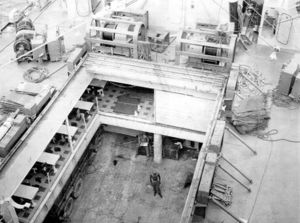Combat loading: Difference between revisions
imported>Subpagination Bot m (Add {{subpages}} and remove any categories (details)) |
imported>Howard C. Berkowitz (Added administrative loading and placeholders for examples) |
||
| Line 1: | Line 1: | ||
{{subpages}} | {{subpages}} | ||
[[Image:USSRankinCargoHold.jpg|thumb|300px|right|A cargo hold of an [[attack cargo ship]], ready to be combat loaded. The upper level is the main deck, with cargo-handling winches visible. The lower level is the floor onto which cargo is combat loaded. In between is the mess deck where the crew eats their meals.]] '''Combat loading''' is a method of loading [[cargo]] into the ships that will carry it to the site of an [[amphibious warfare|amphibious landing]]. It gives primary consideration to the ease and sequence with which troops, equipment, and supplies can be unloaded ready for combat, rather than to the efficient use of cargo space. | [[Image:USSRankinCargoHold.jpg|thumb|300px|right|A cargo hold of an [[attack cargo ship]], ready to be combat loaded. The upper level is the main deck, with cargo-handling winches visible. The lower level is the floor onto which cargo is combat loaded. In between is the mess deck where the crew eats their meals.]] '''Combat loading''' is a method of loading [[cargo]] into the ships that will carry it to the site of an [[amphibious warfare|amphibious landing]]. It gives primary consideration to the ease and sequence with which troops, equipment, and supplies can be unloaded ready for combat, rather than to the efficient use of cargo space. The latter method is called '''administrative loading'''. | ||
The art and science of combat loading were developed in [[World War II]], and contributed greatly to the success of [[Allied]] amphibious campaigns. [[Attack cargo ship]]s were assigned a specially-trained [[U.S. Marine Corps|Marine Corps]] officer called the "Transport Quartermaster" or "Combat Cargo Officer" to oversee their proper combat loading. | The art and science of combat loading were developed in [[World War II]], and contributed greatly to the success of [[Allied]] amphibious campaigns. [[Attack cargo ship]]s were assigned a specially-trained [[U.S. Marine Corps|Marine Corps]] officer called the "Transport Quartermaster" or "Combat Cargo Officer" to oversee their proper combat loading. | ||
| Line 17: | Line 17: | ||
Combat loading normally requires the use of each of these methods, with the vertical and block method predominating. | Combat loading normally requires the use of each of these methods, with the vertical and block method predominating. | ||
==Impact of using, or not using, combat loading== | |||
===Gallipoli Campaign=== | |||
===Bay of Pigs=== | |||
===Guadalcanal Campaign=== | |||
===Falklands War=== | |||
==References== | ==References== | ||
*[http://www.lejeune.usmc.mil/mccsss/schools/los/files/lessons/TEO/C105.pdf#search=%22%22combat%20loading%22%20amphibious%22 U.S. Marine Corps: Introduction to Amphibious Embarkation Planning] | *[http://www.lejeune.usmc.mil/mccsss/schools/los/files/lessons/TEO/C105.pdf#search=%22%22combat%20loading%22%20amphibious%22 U.S. Marine Corps: Introduction to Amphibious Embarkation Planning] | ||
Revision as of 14:03, 29 May 2008

Combat loading is a method of loading cargo into the ships that will carry it to the site of an amphibious landing. It gives primary consideration to the ease and sequence with which troops, equipment, and supplies can be unloaded ready for combat, rather than to the efficient use of cargo space. The latter method is called administrative loading.
The art and science of combat loading were developed in World War II, and contributed greatly to the success of Allied amphibious campaigns. Attack cargo ships were assigned a specially-trained Marine Corps officer called the "Transport Quartermaster" or "Combat Cargo Officer" to oversee their proper combat loading.
When a ship is combat loaded, each item must be stored so it can be unloaded at a time and in a sequence that will most effectively support the planned activities ashore. Whenever possible, the loading scheme must also provide flexibility to accommodate changes in the tactical plan, and to allow access to cargo that is required to meet emergency calls for equipment or supplies.
Methods
There are three basic methods of arranging items in a cargo hold:
- Horizontally
- Where a single item or class of items—say, rifle ammunition—is stored in a layer that fills the hold from side to side and front to rear. This allows maximum access to the item once it is uncovered.
- Vertically
- Where like items are stored in columns that go from the top of the hold on down, so that several types of items are available during any stage of emptying the hold. This means that if four different items, such as food, water, medical supplies, and ammunition, are stored in a single hold, each of these supplies would have be accessible without first unloading a layer of another one.
- In blocks
- Where assortments of various types of items are made up and loaded together. With this system, a balanced proportion of the entire cargo can be unloaded without disturbing the rest of the cargo.
Combat loading normally requires the use of each of these methods, with the vertical and block method predominating.